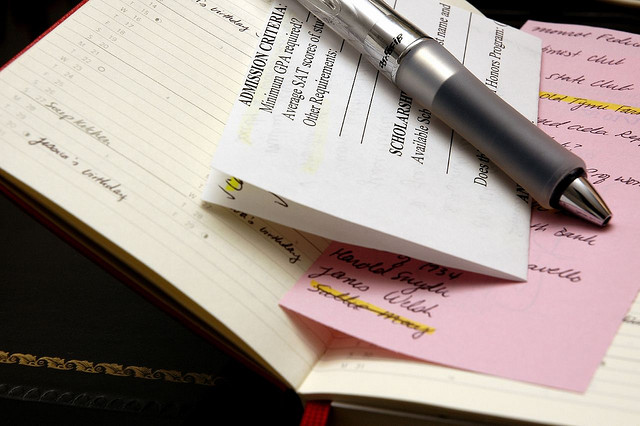College application essays and personal statements are important deciding factors to score admission tickets to the U.S. institutions. For undergraduate degrees, prospective students are asked to write several short essays in various topics depending on the schools they apply to. Meanwhile, prospective graduate students are required to write one longer essay (generally two to three pages), often called “Personal Statement”, relevant to their research or working experience, their passion, as well as future directions. In this post, I will be covering personal statements mainly for graduate applications. If you need hands-on help with your essays, check out Indonesia Mengglobal’s initiative on personal statement review service.
Personal Statement in a Nut Shell
Your personal statement in graduate school is meant to serve as a medium of communication between the admission committee and you. It is the only place where you can voice your unique qualifications for and commitment to your chosen field. It is the chance for you to shine as an individual in your own words in the application process. According to all three of my research advisers, this piece of paperwork is the first thing they look for in any graduate school applications. Along with your GPA, letters of references, and GRE (or GMAT) scores, personal statement plays an important role in deciding whether to invite you for an interview or offer.
What Does the Admission Committee Look For?
Each institution has different priority on the type of candidates they seek for. Make sure to do a thorough research on what attributes your desired institutions are looking for in their ideal candidates. This could be done through internet, asking alumni or students there, or anything you could possibly think of. Several possible traits that the admission committee are looking for: strong academic potential and qualities, passion and motivation for the related field, writing and thinking ability, a sense of future including ambitions and goals, work and research experience, accomplishments, and many more.
Getting Ideas
One of the hardest steps in writing a personal statement is finding the topic you want to write. Most applicants will write topics relevant to their efforts to reach where they are now, which may include their research and working experience as well as accomplishments (such as published papers). To give you a better picture, let me give you some examples. Below are the prompts for my graduate applications at Carnegie Mellon University and Northwestern University respectively:
“What are your reasons for undertaking graduate study at Carnegie Mellon University? How do your experience, your education and graduate training, and your future career plans relate to each other?”
“Please use the space provided to explain your immediate and long term research and occupational goals with respect to your intended field of study. Please indicate why you have chosen to pursue your study at Northwestern University, and provide details regarding your particular areas of academic interest.”
Unlike undergraduate college application essays, notice that most prompts for personal statement are typical. In short, these two prompts are asking you: why you are pursuing this field of study (and not others) and what the exact steps you have tried to achieve it. Personal statement is meant to be specific and detail oriented but certainly not too meticulous or wordy.
This type of essays may be easy for applicants who already know exactly the specific area of research they want to do. However, for many others, they only know the direction they want to pursue. In the later case, you are encouraged to explore and exploit yourself. Here are some things you may do to get your writing started:
- Patch Writing: Unless you are a good writer, don’t try to write the whole personal statement all at once. Try to take notes as you are thinking about what you should write in your personal statement. Try to brainstorm: your strengths, areas of interests, achievements, etc. Write them down and expand later. Sometimes, the best ideas come up when you least expect it, perhaps you get inspired after watching a movie. Again, take time to write your personal statement, don’t cram it in 1-2 nights!
- Talk to Others: Discussion with others can also help you discover your “hidden” strengths, traits, and interests. Talk to your research advisers, friends you trust, or mentors! I talked to one of my professors in undergrad and did a brainstorm with him on what I can write in my personal statement. He definitely helped me a lot in popping up a lot of good ideas. Be mindful, talking to others does not mean asking them for good ideas. A good personal statement needs to be genuine and that can only be achieved if the ideas come straight from your heart (not theirs).
- Look for Inspirational Source: Reading or listening to inspirational talks certainly assists you write good stuff. One concrete example, I listened to Steve Jobs Commencement speech when I was seeking for ideas for my personal statement. It totally helps.
- Research: Do a thorough research on your field, the direction of your area of focus, and the institution of your choice. Despite the fact that the prompts of personal statement look very similar, every personal statement you write for every school should be different (if not partially). Your personal statement has to be tailored individually to each school and trust me, the admission committee knows who “copy and paste” their statements and who don’t. Most likely, the later group gets the golden ticket. TIPS: If you are applying for research positions, you should definitely find out what your desired Principal Investigators, often abbreviated as PI (or Research Advisers), look for. In the U.S., most of the times, it is completely acceptable to email the students under your desired PI research group. These students, often times, would provide you with information about the group working environment and other information that you may not find publicly. However, also be mindful to make a good impression with these students, they may influence your PI decision!
Drafting Personal Statement
Once you decide on an idea, now it is the time to write. Take one topic and write. You may also do an outline before you start writing. Some people work better with an outline, some people don’t. I personally feel outlining is probably the best way to keep your essay holistic. I strongly encourage you to start early (rule of thumb: 1-2 months before deadline) on your statement and write as many drafts as you need before submission.
“Secrets” to write a good statement:
- Hook your readers: Try to create picture for your readers through your writing. This helps your essay shine. You can always check for good hooks from inspirational speeches. An example of a good hook: Martin Luther King, Jr’s speech, “I have a dream that my four little children will one day live in a nation where they will not be judged by the color of their skin but by the content of their character. I have a dream TODAY!” MLK Jr creates the “hook” to the audience (in your case, readers) by saying “I have a dream”. This way, the audience can vividly picture his dream and get hooked.
- Holistic: each paragraph needs to establish good connections between one another. Every sentence has to flow and be easy to read.
- Great start and awesome end: the beginning of the statement needs to be attractive (and easy to remember) without overdoing it. Good first impression generally adds some points. The end of the statement is also very significant. A good start and end needs to aspire “call to action”. In this case, it should be: I want this candidate!
Once you finish writing your statement, at the very basic, remember to check your grammar (spellings etc) and connections. Admission committee is not going to try figuring out what you are trying to tell them if they don’t understand your essay. Have several proofreaders before submission. Your proofreaders have to be somebody you fully trust and have the ability as well as willingness to constructively criticize you.
List of potential good proofreaders:
- Professors who know you in person
- Principal Investigators or Research Advisers
- English teachers or instructors
- Writer’s workshop
- Mentors and friends
What to look for when drafting:
- Have I shown passion, efforts, accomplishments, and future direction?
- Do I have enough detail?
- Is it easy to follow?
- Is this the best set of stories I have?
- Am I ready for the challenges I may face in the future?
- Am I honest?
If the answer of any of this question is “NO”, you should definitely go back and revise. Lastly, I really want to emphasize: BE YOURSELF! Avoid using cliché or try to be somebody else. Personal statement is the only best place for you to express yourself and “talk” to the admission committee. Don’t miss the chance.
Submission
Once you have your final version personal statement ready, check for the very last time before submission. Don’t wait till the last minute to submit your personal statement. Give several buffer days, just in case “technical difficulty” arises.
Lastly, writing a personal statement can both be painful and fun yet it all depends on how you look at it. Trust me, you’ll discover much more of yourself through this seemingly overwhelming task. Now… don’t fret, enjoy the process, and write! Good luck! 🙂
Photo Credit: haagenjerrys via flickr










[…] Hate It or Love It: Personal Statement by Stevia Angesty […]
very useful. thank you.